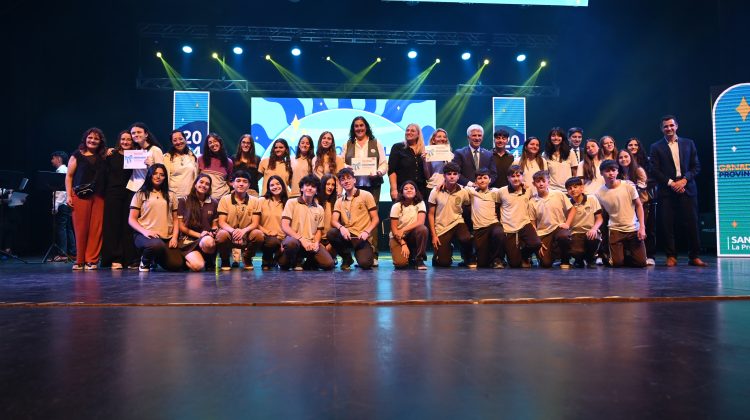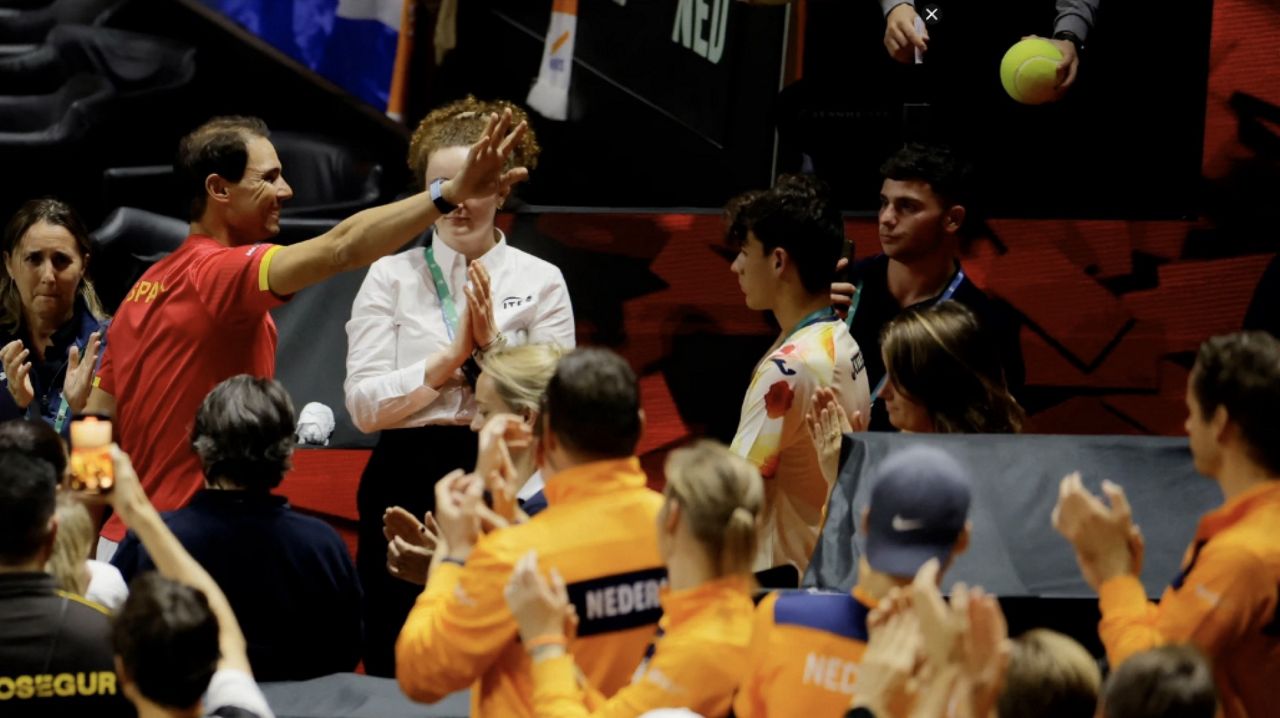November 20, 2024 | 11:55
Wednesday, November 20, 2024 | 11:55
Governor Claudio Poggi accompanied students from all over the province who were recognized for their participation in the 2024 Edition. There were mentions for the participatory category and awards for the competitive stage, which included educational trips to the Sierras Centrales and the Costa de los Comechingones, with everything included.
Governor Poggi enjoyed himself like one more at the San Luis Cinema Theater and received the affection of the boys.
The 2024 Edition of the Cultural Intercollegiates was once again a demonstration of color, skill and creativity. Students from the Primary and Secondary levels from all over the province presented their projects throughout the year in different thematic areas: authors from San Luis, environment and sustainable development and Libertador José de San Martín.
It is not the first time that the Cine Teatro San Luis welcomes the children, since the different local and regional bodies met on the same stage and, as happened before, once again moved their families and teachers.
“Welcome to those who have traveled from the interior and the kids from the city. Today we are closing the cycle of the Cultural Intercollegiate, where in addition to the awards, the different cultural disciplines have been highlighted. In addition to congratulating them, we extend our greetings to the more than eight thousand boys from all over the province who joined this edition“, to its teaching teams, managers, to the Ministry of Tourism and Culture, its minister and team, to the Ministry of Education, for facilitating the organization of this, which tends to strongly incorporate culture into our identity, in this case educational” celebrated the Governor Poggi, who was received by the Minister of Education, Guillermo Araujo; his partner from Tourism and Culture, Juan Manuel Rigau; the director of Cultural Management and Sanluiseña Identity, Karina Giordani, and the deputy director of Cultural Intercolegiales, Sebastián Pablo Muñoz.
Both the mentions and the awards were very federal, since they included boys from Nova Scotia, Merlo, Tilisarao, Fraga, city of San Luis, Villa Mercedes, Naschel, Concarán, Carpintería, El Retamo, Los Molles, Juana Koslay, Batavia, Villa del Carmen, Candelaria, Las Aguadas, Fortuna, Fortín El Patria, Río V, Las Isletas, Los Chañares, Santa Martina, Santa Ana, Luján, San Roque, Desaguadero and La Punta.
The initiative posed the challenge of promoting the San Luis identity, both individually and collectively, through multiple supports in the disciplines of theater, visual and audiovisual arts, literature, music and dance. In each instance, the productions (both on stages and in audiovisual totems) They reflected the sense of belonging and allowed us to build a seedbed of local talent.
“Today the closing and awards of the Intercollegiate Cultural Awards take place at the Cine Teatro San Luis, celebrating 10 years since its first edition in 2014. Students from all regions of the province participated, including smaller towns. Primary schools participate non-competitively and secondary students in competitions, with prizes for all, including trips and equipment for the schools. The awards for the Initial level will begin next week,” Muñoz summarized.
A team of professionals in the different artistic branches with knowledge of the provincial cultural heritage selected the winners of this 2024 Edition for the Secondary level (competitive modality) and a highlight by educational region for the Primary level (participatory modality).
The first block opened with an institutional video and then gave way to the delivery of special mentions at the Secondary level and the recognition of third places in the Regional stage. Then followed the awards to outstanding Primary level students, with an artistic presentation whose theme was ‘Authors from San Luis’.
The second included the recognition of the second places in the Regional stage, the delivery of recognition to outstanding teachers and the artistic presentation with the thematic axis ‘Environment and sustainable development’. In the third block, the first places in the Regional stage were recognized, in this case the thematic axis was ‘The Liberator General San Martín’.
Finally, in the fourth block, awards were given to the winning students of the Provincial stage (only first places in each discipline), to the winning schools by percentage of participation (5 schools) and to the winning school by score.
Maximiliano Cuello, who works with the Wayra Generative School and the San Agustín Institute, said that the contest “seemed to us an excellent opportunity to address various topics and to experiment and investigate the proposals that the children have and everything they carry within them regarding artistic expression.”
Juliana Altamirano, who participated with a dance group, said that “we love it when they look at us because it is very nice to dance up there. More than anything we really liked how we became familiar with the group.”
Joaquín Mateo said that he had the opportunity to go on stage several times in this and previous editions: “It is beautiful to think that in the band we did not know each other before, and that, thanks to the teachers, the directors, the school, we met. They came together and we were able to create those ties, come to participate and show what we are capable of.”
The closing was with a live musical band.
**What measures are in place to ensure that the Cultural Intercollegiates is accessible to students from all socioeconomic backgrounds and communities in San Luis?**
## Interview: Celebrating Creativity and Culture
**Guests:**
* **Maximiliano Cuello:** Representative of Wayra Generative School and the San Agustín Institute, involved in the Cultural Intercollegiates
* **Juliana Altamirano:** Student participant in the dance category of the Cultural Intercollegiates
**Moderator:** Thank you both for joining us today to discuss the success of the 2024 Cultural Intercolegiales. This year’s event showcased a remarkable display of talent and dedication from students across the province.
**Section 1: Fostering Creativity and Identity**
* **Maximiliano**, as an educator involved in prompting student participation, can you elaborate on how the Cultural Intercolegiates encourages creative expression and exploration among the students? What specific opportunities does it provide for them to delve into their artistic talents and passions?
* **Juliana**, what inspired you to participate in the dance category? How did the experience contribute to your personal and artistic growth? Did you find that you were able to connect with your San Luis identity through dance?
* How does the competition aspect of the Intercollegiates impact the participants? Does it serve as a motivator, or does it introduce potential pressures?
**Section 2: Cultural Impact and Accessibility**
* The article mentions that the Intercollegiate event has been running for ten years and has reached students from various towns and communities across San Luis.
* **Maximiliano**, how has the event evolved over the years? What changes have you observed in terms of student engagement, community participation, and the overall scope of the program?
* **Juliana**, did you come across students from diverse backgrounds during the competition? How did the event contribute to fostering a sense of unity and shared identity across different communities?
* The article highlights the program’s emphasis on accessing cultural opportunities for everyone. Do you believe that the Intercollegiates succeeds in breaking down barriers and ensuring inclusivity in cultural participation?
**Section 3: Educational Value and Future Prospects**
* **Maximiliano**, how do you see the Cultural Intercollegiate program contributing to the broader educational goals of the province? What skills and values do students develop through their involvement?
* **Juliana**, beyond the artistic skills you honed, what other valuable lessons did you learn through participating in the Intercollegiates?
* Looking ahead, what are your hopes and aspirations for the future of the Cultural Intercollegiate program? How can it continue to evolve and expand its impact on the youth of San Luis?
**Closing:**
Thank you both for sharing your insightful perspectives. Your experiences clearly demonstrate the significant impact of the Cultural Intercollegiate program in fostering creativity, cultural awareness, and community engagement amongst students in San Luis.


